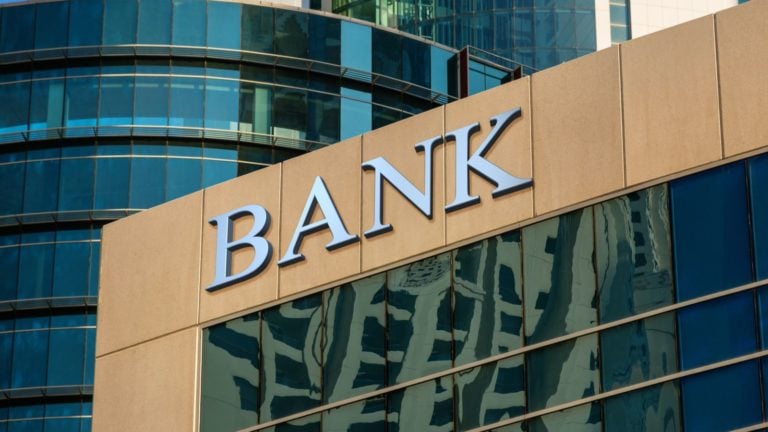The search for top dividend-paying financial stocks is on. Of course, in this market environment, stability matters more than growth. Banks that provide steady dividend income may be considered relatively stable without a financial crisis.
Indeed, 2008 shook investors’ confidence in this sector. While it doesn’t appear like we’re on the brink of yet another financial calamity, it’s in investors’ minds. Additionally, the reality that banks are cyclical, and perform better in bull markets, is something to be contended with for long-term investors looking to buy this space right now.
That said, there are reasons to consider dividend-paying financial stocks right now. These companies have stable cash flows, which support their dividend payments over time. They’re also deeply embedded in the economy. Thus, they should perform in line with the market over the long term.
With that said, here are three top dividend-paying stocks to buy right now.
| BAC | Bank of America | $34.36 |
| JPM | JPMorgan Chase | $142.88 |
| GS | Goldman Sachs | $366.04 |
Bank of America (BAC)

A leading global bank, Bank of America (NYSE:BAC) is certainly among the dividend-paying financial stocks worth putting on any buy list. This leading global financial institution provides an extensive array of financial products and services, catering to a diverse clientele, including retail customers, affluent investors, major corporations, and governmental bodies.
The firm offers comprehensive financial solutions spanning banking, investment, asset management, and risk management. Bank of America generates most of its revenue from its operations in the United States while maintaining a presence in numerous countries worldwide. Bank of America is the second-largest commercial bank in the U.S., standing just behind JPMorgan Chase, with its total assets reflecting its immense size and reach.
As of September 2022, the bank boasted a whopping $3.1 trillion in assets, out of which a significant amount was concentrated in its U.S. operations. This formidable financial institution has established a strong presence globally, cementing its status as a critical player in the banking and finance industry.
In the fourth quarter of the 2022 fiscal year (FY), the company’s revenue surged by 11% year-over-year (YOY), totaling $24.5 billion. The company also disclosed that its net income for the same quarter was $7.1 billion, a marginal increase from the $7 billion recorded in the preceding year.
Bank of America is a promising option for that investing in financial stocks. The company’s current forward price-to-earnings ratio of 9.5 is relatively low, and it also boasts a steady and sustainable dividend yield of 2.6%, with a payout ratio of 26.9%. This presents an attractive investment opportunity, especially since Bank of America is well-positioned to navigate any challenges that may arise in 2023, with the potential for substantial growth once the economy bounces back in 2024 or beyond.
JPMorgan (JPM)

Next on this list of dividend-paying financial stocks to buy is JPMorgan Chase (NYSE:
JPM), another leading mega-cap U.S.-based bank. Like Bank of America, JPMorgan is a blue-chip bank known for its size and exceptional balance sheet. The strength of this financial giant was evident in its first-quarter earnings report, which revealed earnings per share of $3.57 and revenue of $34.55 billion, surpassing the expectations of analysts.
An examination of JP Morgan’s financial statements reveals a non-interest income that is 33% higher than that of BAC, which implies that JP Morgan may receive less assistance from rising rates. However, this offers the safety of multiple income streams for long-term investors.
JPMorgan provides a detailed revenue and net income breakdown across various business segments, including Consumer & Community Banking, Corporate & Investment Bank, Commercial Banking, Asset & Wealth Management, and Corporate. However, unlike the overall financial figures of JPMorgan, the breakdown of the business segments is presented on a non-GAAP basis.
JPMorgan’s Commercial Banking division provides clients various financial solutions, including loans, payment services, asset management, and investment banking products. The segment caters to a diverse client base, including small businesses, medium to large-sized corporations, and local governments, ensuring comprehensive financial support for various entities.
Additionally, JPMorgan’s Asset & Wealth Management division offers comprehensive services across various asset classes and manages many client assets totaling $4.3 trillion. Apart from asset management, the segment provides a wide range of financial products and services, including retirement products, brokerage services, and banking solutions, ensuring clients can access diverse financial support.
Goldman Sachs (GS)

Rounding out this list of dividend-paying financial stocks to buy is Goldman Sachs (NYSE:GS). The largest investment bank on this list, Goldman Sachs, focuses on managing money for big-time clients, providing research and other high-value activities to generate money via its asset and wealth management divisions.
Goldman Sachs provides customers with a wide range of financial products and services, including investment advisory, asset management, trading, and underwriting services, catering to a broad range of clientele.
Indeed, Goldman Sachs’ investment banking division has been responsible for managing initial public offerings (IPOs) for various companies in recent years. Of course, with the business drying up, demand for GS shares has waned relative to many of its peers of late.
This has led to a forward price-to-earnings ratio of 10.2 times, which is lower than the sector median value of 13.76. Although it may need to improve its balance sheet, Goldman Sachs demonstrates strong revenue growth and profitability that exceeds the average level.
According to Wall Street analysts, GS is considered a moderate buy with an average price target of $403.15, suggesting a potential increase of more than 10%. This makes GS one of the Dow stocks with the most undervalued potential to purchase.
On the date of publication, Chris MacDonald did not have (either directly or indirectly) any positions in the securities mentioned in this article. The opinions expressed in this article are those of the writer, subject to the InvestorPlace.com Publishing Guidelines.
